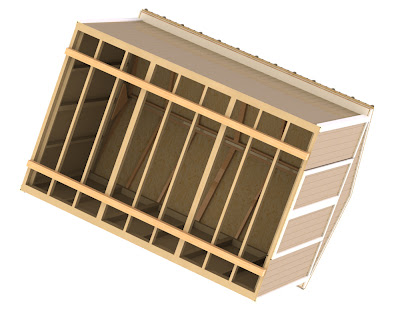When I
was growing up, my family didn't have a lot of money, so we had to come up with
creative and inexpensive solutions. When my dad wanted to build something, he
would think about it for a while. Then he would find some paper and a pencil
and sketch up a dimensioned drawing of the project.
I saw him
do this with something as simple as a birdhouse all the way up to a built-in
corner cabinet for our house. With this type of sketch, he could also figure out
exactly what materials would be needed for the project build. Using this
process, he could think about how to find and or buy the required building
materials.
I'm not
sure how this influenced my own choices over time, but I do know that I have
applied this same process to my ever-evolving design thinking. When I set out
to do a new project, I start by drawing a dimensional sketch. Then I look at
the most cost effective way to produce what I am planning to build. Once all
that is done, I can look at the build versus buy options.
Although
I know how to draw up my plans using a pencil and paper, there are much more
advanced tools available today. Let me explain the more modern approach to
creative problem solving, as it applies to a simple shed project.
Problem=
I have too much stuff
Solution=
Get rid of stuff
Increase storage capacity
As I have
mentioned in previous posts, I am trying to set up a studio workspace in my
basement. My wife and I both paint and we also have a lot of supplies and
equipment that we use for mural painting.
We want
to clear out some of less used equipment and only have so much space in our
garage. So, we looked into putting an 8’ x 12’ storage shed in our back yard. We went out and looked at
the various kits available at the big home improvement stores.
An 8’ x 12’ storage shed kit with floor
costs around $1200. From my research, many of these complete kits come bundled
with material that many times are warped or twisted and need to be replaced,
thereby increasing cost. All of these kits are made to stay together once
built, so if you ever move you have to try and move a large shed or leave it
behind and start over at your new place?
So, I
decided to do a cost comparison between what the home improvement stores offer
and what I could build myself. Just to make it interesting, I thought I would
design my shed so that it could be made of bolted together sections that could
be disassembled and easily moved on a small trailer. Another advantage of
building your own, is the option of picking out the best materials that are
available at the building store.
First up…Draw the shed.
I now use a computer program called SolidWorks to “draw” my projects. Solidworks is a
high-end 3D solid modeler program that allows me do design full-scale and
assign materials to each part. There is an integrated program called PhotoView
360, which allows me to render a realistic image of the finished design.
I drew up each part of the shed, full-size and fully dimensioned. Then I added the appropriate materials and appearances to each components. Below are renderings of the shed assembly that were generated using PhotoView 360.
Using this software to design my project allows me to rotate to any angle or view, zoom in, hide or make parts transparent. I can then make the typical orthographic projection drawings from the 3D parts because they are already fully dimensioned. Creating a drawing is all drag and drop once the assembly file is built and saved.
I then created an Excel spreadsheet to determine what the overall cost of this project would be. I haven't added in the cost of the metal roof or hardware yet, but you can get the general idea. I can pick out my own materials (which will be straight) and build this shed for at least $500.00 less than buying a take-what-you-get kit.
Thanks to my Dad for giving me these problem solving skills. They have been quite valuable over the years. Not to mention, I learn a lot on each of these explorations.








No comments:
Post a Comment